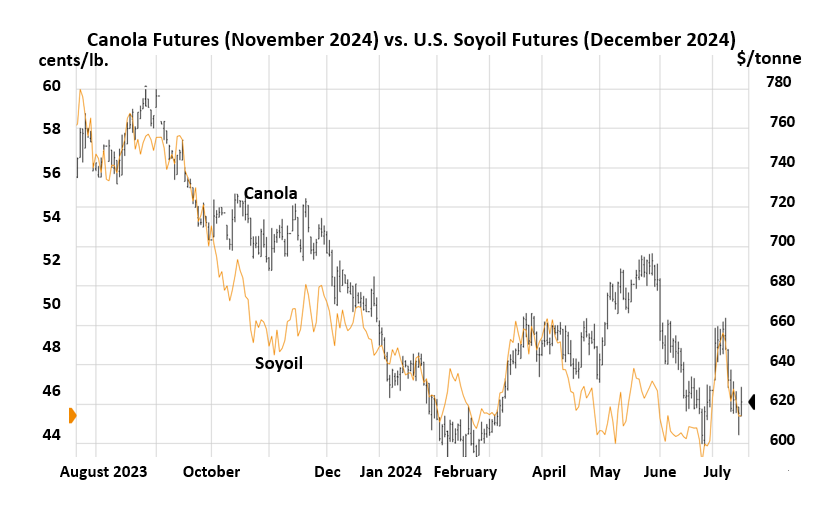Government mail service may be affected by the Canada Post labour disruption. See how to send and receive government mail during this time.
See event listings and more articles in this edition of Agri-News: July 22, 2024 issue
“Canola prices eroded from last August to a February low,” explains Neil Blue, provincial crops market analyst with the Alberta government. “Following a seasonal pattern, canola prices rose during the spring, gaining over $100/tonne from those February lows.”
However, during June, canola prices again moved lower and have traded around in a lower range, coming close to but remaining above the February lows near $600/tonne for the November futures contract. These price levels are historically strong, although much below the record-high prices of June 2022.
There are several factors affecting canola prices and constraining a significant price rally. Despite the dryness in much of western Canada last summer, 2023 canola yields were close to average and much above the drought-reduced yields of 2021.
Canadian Grain Commission data shows that 11 months into the 2023-24 crop year, producer deliveries of canola were 16.6 million tonnes, just below the year ago level. Domestic use of 10.25 million tonnes, mainly canola crushing, is 900,000 tonnes above year ago at the end of June and is on pace to set a crop year record.
Conversely, Canadian canola exports to June 30 are 1.35 million tonnes below last year’s pace. The lower total Canadian canola use will lead to a further increase in canola carryover, although still not as high as in 2018 and 2019.
Canola prices are closely related to world vegetable oil prices. For example, U.S. soybean oil prices have had a similar price movement as canola during the last year as shown in the chart below.
Figure 1. Canola futures vs. U.S. soyoil futures

Regarding 2024 crop prospects, canola crops in the Canadian Prairies and the U.S. are in overall good condition to mid-July. The U.S. soybean crop is rated as 68% good to excellent condition, higher than last year’s 57% rating in mid-July. South American soybean production, despite being reduced in Brazil due to dryness, was high overall and is currently being marketed to the world.
“Subject to a major crop threatening weather development, market action indicates expectations of average or higher production of northern hemisphere oilseed crops. Mediocre western Canadian canola basis levels indicate complacency among buyers,” says Blue.
Another factor affecting markets is the speculative fund position, which is reported to be record short in U.S. soybean futures. Development of a weather threat could lead to funds buying back some of those short positions and that could cause the canola price to rally. That happened in early July and, although the price rally was temporary, it did provide a brief pricing opportunity.
“Following crop markets is a year-round activity, even when there are no crops in the bin,” says Blue. “Although prices have moderated from those of 2022, it is potentially profitable strategy to have target prices in mind and keep at least in casual contact with the markets to be able to take advantage of pricing opportunities when they arise.”
For more information, see:
Contact
Connect with Neil Blue for more information:
Phone: 780-422-4053
Sign up for Agri-News
Start every Monday with the week’s top agricultural stories and latest updates.
Read about all things agriculture at Alberta.ca/agri-news